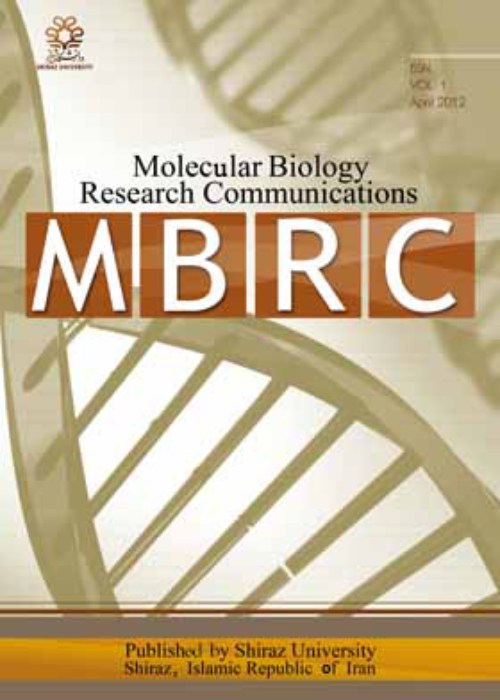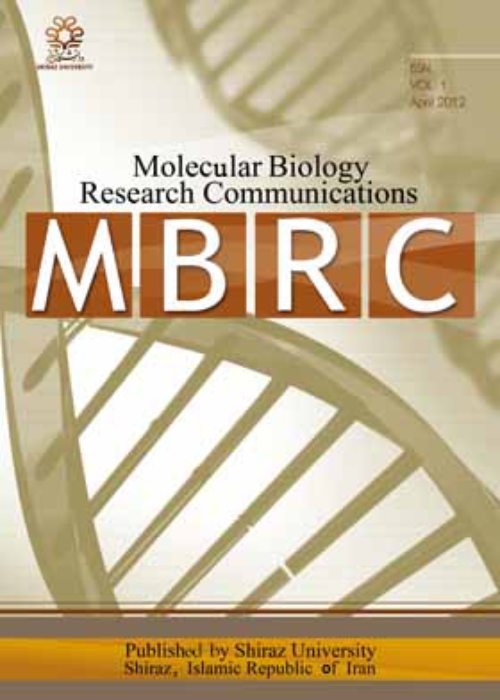فهرست مطالب

Molecular Biology Research Communications
Volume:12 Issue: 1, Mar 2023
- تاریخ انتشار: 1402/01/07
- تعداد عناوین: 5
-
-
Pages 1-16Extracting high-yield, high-quality DNA from plant samples is challenging due to the presence of the cell wall, pigments, and some secondary metabolites. The main CTAB method, two of its modified protocols (beta-mercaptoethanol or ammonium acetate were eliminated), the modified Murray and Thompson method, and the Gene All kit were statistically compared based on the quantity and quality of the total DNA (tDNA) extracted from fresh and dried leaves of three medicinal herbs P. harmala, T. ramosissima, and P. reptans. The suitability of the tDNAs for molecular studies was evaluated by polymerase chain reaction (PCR) of the fragments of the internal transcribed spacer (ITS) in nuclear DNA and the trnL-F region in chloroplast DNA. Some significant differences were found between the tDNAs extracted by five extraction methods. With the exception of P. harmala, where the PCR of both the ITS fragments and the trnL-F region worked successfully in all DNA samples, but only the ITS fragments, not the chloroplast trnL-F region, were amplified in the DNA samples of T. ramosissima and P. reptans. The chloroplast trnL-F region was amplified only in DNA samples extracted from fresh and dried leaves of the three studied herbs using the commercial kit. Gene All kit, the main CTAB method, and its modified protocols were the less time-consuming protocols that yielded DNA suitable for downstream PCR vis-a-vis the modified Murray and Thompson method.Keywords: Peganum harmala L, Tamarix ramosissima Ledeb, Potentilla reptans L, DNA extraction, CTAB, Murray, Thompson method
-
Pages 17-25Despite various treatment options available for colorectal cancer, the survival rates for patients remain low. This study investigated the effects of hyperthermia and Ibuprofen on human colorectal adenocarcinoma cells (HT-29) viability, proliferation, and gene expression related to tumor suppression, Wnt signaling pathways, proliferation, and apoptosis The cells were exposed to hyperthermia at 42 or 43°C for 3 hours or Ibuprofen at different concentrations (700-1500 μM), and the effects were analyzed through MTT assay, trypan blue staining, and quantitative Real-time PCR. The study used quantitative Real-time PCR (qRT-PCR) to evaluate the effect of hyperthermia and Ibuprofen on the expression of various genes associated with tumor suppression, proliferation, Wnt signaling pathway, and apoptosis. The results revealed that hyperthermia caused a minor reduction in the viability and proliferation of HT-29 cells, but the decrease was not statistically significant (P<0.05). On the other hand, Ibuprofen caused a concentration-dependent decrease in the viability and proliferation of HT-29 cells. Both hyperthermia and Ibuprofen reduced the expression of WNT1, CTNNB1, BCL2, and PCNA genes, and increased the expression of KLF4, P53, and BAX genes. However, the changes in gene expression were not statistically significant in cells treated with hyperthermia. The findings suggest that Ibuprofen is more effective in reducing cancer cell proliferation by promoting apoptosis and inhibiting the Wnt signaling pathway than hyperthermia, which had some impact but was not statistically significant. The study highlights the potential of Ibuprofen as a targeted therapy for colorectal cancer.Keywords: Colorectal cancer, Hyperthermia, HT29 Cells, Ibuprofen, Wnt Signaling Pathway
-
Pages 27-36Scorpion venom contains various toxin peptides with pharmacological and biological properties. Scorpion toxins specifically interact with membrane ion channels which play key roles in progression of cancer. Therefore, scorpion toxins have received special attention for targeting cancer cells. Two new toxins MeICT and IMe-AGAP, isolated from Iranian yellow scorpion, Mesobuthus eupeus, interact specifically with chloride and sodium channels, respectively. Anti-cancer properties of MeICT and IMe-AGAP have been determined before, in addition they show 81 and 93% similarity with two well-known anti-cancer toxins, CTX and AGAP, respectively. The aim of this study was construction of a fusion peptide MeICT/IMe-AGAP to target different ion channels involved in cancer progression. Design and structure of the fusion peptide were investigated by bioinformatics studies. Two fragments encoding MeICT and IMe-AGAP were fused using overlapping primers by SOEing-PCR. MeICT/IMe-AGAP chimeric fragment was cloned into pET32Rh vector, expressed in Escherichia coli host and analyzed by SDS-PAGE. The in silico studies showed that chimeric peptide with GPSPG linker preserved the three-dimensional structure of both peptides and can be functional. Due to the high expression of chloride and sodium channels in various cancer cells, MeICT/IMe-AGAP fusion peptide can be used as an effective agent to target both channels in cancers, simultaneously.Keywords: IMe-AGAP, MeICT, Anti-cancer peptides, Chimeric peptide, Scorpion toxins
-
Pages 37-49Toxicity and autophagy effects of a new complex of platinum II (CPC) were evaluated on HeLa cells cultured on a PCL/gelatin electrospinning scaffold. HeLa cells were treated with CPC on the first, third, and fifth days and the concentration of IC50 was determined. The autophagic and apoptotic effects of CPC were examined by MTT assay, Acridine Orange, Giemsa, DAPI, MDC, real-time PCR, Western blot testing, and molecular docking. The cell viability was obtained on days 1, 3, and 5 as much as 50, 7.28, and 19%, respectively with a concentration of IC50 (100μM) of CPC. The staining results indicated that the treatment of HeLa cells with CPC had antitumor and autophagic effects. Results of RT-PCR showed that the expression of BAX, BAD, P53, and LC3 genes was significantly increased in the sample treated with IC50 concentration compared to the control sample whereas the expression of BCL2, mTOR, and ACT genes in cells was significantly decreased compared to the control group. Also, these results were confirmed by Western blotting. The data indicated the induction of apoptotic death and autophagy in the studied cells. The new compound of CPC has antitumor effects.Keywords: Autophagy, Cycloplatinated(II) Complex, mTOR Pathway, Scaffold, Tumor cells
-
Pages 51-55Human leukocyte antigen-DQB1 (HLA-DQB1, OMIM: 604305) is the human major histocompatibility complex (MHC) system. HLA genes are classified into three classes (I, II, and III). The HLA-DQB1 belongs to class II, is mainly involved in the actions of the human immune system and plays a fundamental role in donor-recipient matching in transplantation and can be associated with most autoimmune diseases. In this study, the potential influence(s) of the G-71C (rs71542466) and T-80C (rs9274529) genetic polymorphisms were investigated. These polymorphisms, located in the HLA-DQB1 promoter region, have a significant frequency in the world population. The online software ALGGEN-PROMO.v8.3 was used in this work. The results indicate that the C allele at the -71 position actually creates a new potential binding site for NF1/CTF and the C allele at the -80 position changes the TFII-D binding site into a GR-alpha response element. The NF1/CTF plays the role of activator and the GR-alpha is the inhibitor; thus, according to the roles of these transcription factors, it is suggested that the above-mentioned polymorphisms alter the expression levels of HLA-DQB1. Therefore, this genetic variation is associated with autoimmune diseases; however, this cannot be generalized because this is the first report and more studies are needed in the future.Keywords: GR-alpha, HLA-DQB1, NF1, CTF, Polymorphism


